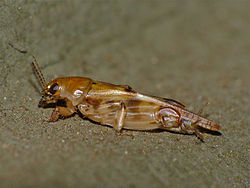| Tridactylidea | |
|---|---|
 | |
| Tridactylus sp. | |
| Scientific classification | |
| Kingdom: | Animalia |
| Phylum: | Arthropoda |
| Class: | Insecta |
| Order: | Orthoptera |
| Suborder: | Caelifera |
| Infraorder: | Tridactylidea Brullé, 1835 |
The infraorder Tridactylidea [1] has a single extant superfamily which includes pygmy mole crickets; they are thought to be sister to all other lineages in the Caelifera, the Orthopteran suborder that includes grasshoppers. [2] [3]